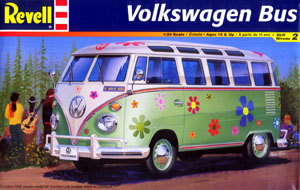Revell's 1/24 Volkswagen Bus | | History When I think of Volkswagen, I think of summer vacations, National Parks, and ringing ears. My family drove a VW bus all over the Western US and Canada, and since I was just a young'un, I had the pleasure of experiencing the lack of soundproofing around the typical Volkswagen rear engine design. Eight hours of sitting on top of a VW engine running at 5000rpm isn't exactly a fun time, but that bus did manage to go just about anywhere without any faults and after 150,000 miles it still sounded the same. 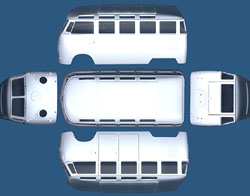 The first VW bus came out as a 'delivery van' in 1950 and quickly became Volkswagen's second most popular selling vehicle (behind the VW Beetle). The early VW bus can be identified by the two-piece front window, which was replaced by a one-piece window in all VW busses after 1967. The VW Bus is still a popular vehicle today and many can still be seen on the roads around the world. The first VW bus came out as a 'delivery van' in 1950 and quickly became Volkswagen's second most popular selling vehicle (behind the VW Beetle). The early VW bus can be identified by the two-piece front window, which was replaced by a one-piece window in all VW busses after 1967. The VW Bus is still a popular vehicle today and many can still be seen on the roads around the world.
The Kit In case you're wondering if you've seen this kit before, if you have the Hasegawa VW Bus kit, it's the same as this one. This is good news for US modelers, as this release is going to be cheaper than the Hasegawa release, and will likely have a larger distribution. The kit is molded in white plastic, with some chrome-plated parts and a couple of clear sprues for the windows. The wheels are vinyl rubber. There's a total of 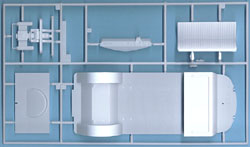 74 pieces in this kit, but not all are needed (some are for other VW Bus versions). The body is molded as one piece, with the tailgate and side doors molded in such a way as to make opening them simple. Unfortunately this isn't true for the front doors, so if you want to model those open you'll have to carefully cut those open. This kit is of the 23 window version, so there's lots of windows to show off the insides even if you leave everything buttoned up. 74 pieces in this kit, but not all are needed (some are for other VW Bus versions). The body is molded as one piece, with the tailgate and side doors molded in such a way as to make opening them simple. Unfortunately this isn't true for the front doors, so if you want to model those open you'll have to carefully cut those open. This kit is of the 23 window version, so there's lots of windows to show off the insides even if you leave everything buttoned up. 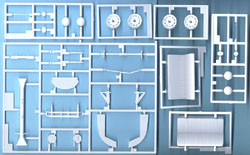 So what do you have to show off inside? Plenty. The VW Bus wasn't exactly known for it's plush interior, so the insides are pretty basic, but the moldings are very well done and look exactly like I remember it from my childhood. You get a front bench and two rear benches, with a bulkhead separating the front bench from the rear two. A rear floor is also provided to make up the basic interior. No seatbelts are included and you'll want to add those. This was a vehicle before shoulder straps, so you'll want to keep that in mind. I believe that they all had manual transmissions, too, so you also get the gear shifter to add in. I seem to remember a VW logo on the shift knob of my parent's van, so get out your 3-hair paintbrush and put one on. So what do you have to show off inside? Plenty. The VW Bus wasn't exactly known for it's plush interior, so the insides are pretty basic, but the moldings are very well done and look exactly like I remember it from my childhood. You get a front bench and two rear benches, with a bulkhead separating the front bench from the rear two. A rear floor is also provided to make up the basic interior. No seatbelts are included and you'll want to add those. This was a vehicle before shoulder straps, so you'll want to keep that in mind. I believe that they all had manual transmissions, too, so you also get the gear shifter to add in. I seem to remember a VW logo on the shift knob of my parent's van, so get out your 3-hair paintbrush and put one on.
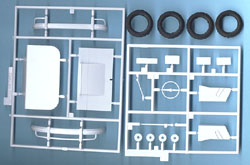 The dashboard is a separate piece that fits into the main body, with the steering column and steering wheel as separate pieces. The large steering wheel looks the part and the dash is slightly different from what I remember, but my parents had a slightly later model and I'm sure the insides changed from year to year. The only thing that is missing from up front are the pedals, but those shouldn't be too hard to add. The dashboard is a separate piece that fits into the main body, with the steering column and steering wheel as separate pieces. The large steering wheel looks the part and the dash is slightly different from what I remember, but my parents had a slightly later model and I'm sure the insides changed from year to year. The only thing that is missing from up front are the pedals, but those shouldn't be too hard to add.
Looking under the van, you get a very nice-looking front suspension made up of over 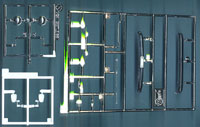 a dozen pieces, not counting the wheels & tires. It appears that once completed you'll be able to move the front wheels as well (wouldn't it be neat if they connected that to the steering wheel as well?). The rear suspension assembly also includes the lower visible section of the engine, including the manifold and muffler. There's a lot of painting to do here, and the instructions do a good job of outlining what is painted what. a dozen pieces, not counting the wheels & tires. It appears that once completed you'll be able to move the front wheels as well (wouldn't it be neat if they connected that to the steering wheel as well?). The rear suspension assembly also includes the lower visible section of the engine, including the manifold and muffler. There's a lot of painting to do here, and the instructions do a good job of outlining what is painted what. 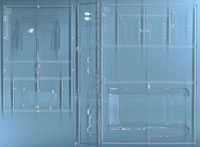 The exterior of the body gets the usual window treatment, with a total of five pieces used to fill all 23 windows. Other clear parts take care of the headlights, taillights, and turn signal covers, with the taillights and turn signal covers needing some coloring on the insides, with the tail ones being split amber and red. That could be a challenge to paint. The bumpers are chrome and you get two choices of license plate holders (European style and US style). You also get two styles of side mirrors to choose from. Other exterior details include windshield wipers and door handles. The exterior of the body gets the usual window treatment, with a total of five pieces used to fill all 23 windows. Other clear parts take care of the headlights, taillights, and turn signal covers, with the taillights and turn signal covers needing some coloring on the insides, with the tail ones being split amber and red. That could be a challenge to paint. The bumpers are chrome and you get two choices of license plate holders (European style and US style). You also get two styles of side mirrors to choose from. Other exterior details include windshield wipers and door handles.
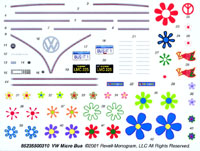 The decals provide factory pin striping and a custom "Flower Power" VW. The factory scheme is in cream and red, with the decal pinstriping in silver and red. The custom scheme is finished in cream and sea foam green, with lots and lots of flowers all over it. The decals themselves are screen printed and some of the flowers have a strong screen pattern to them, as do the Illinois license plates. Other decals include the VW emblem to go on the front of the van and the Volkswagen text to go on the rear tailgate. The decals provide factory pin striping and a custom "Flower Power" VW. The factory scheme is in cream and red, with the decal pinstriping in silver and red. The custom scheme is finished in cream and sea foam green, with lots and lots of flowers all over it. The decals themselves are screen printed and some of the flowers have a strong screen pattern to them, as do the Illinois license plates. Other decals include the VW emblem to go on the front of the van and the Volkswagen text to go on the rear tailgate.
Conclusion This is an excellent kit of the famous VW Bus and should be a fast build for even the beginner modeler. The interesting color scheme these early VWs wore will make for a slightly more difficult finish, but once done it should really look sharp sitting next to a new VW Beetle. | 


 




|
